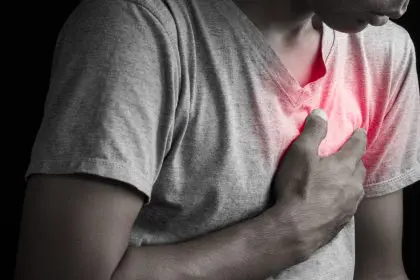Your heart has been doing its job faithfully for years, beating steadily in the background while you go about your daily life. Then suddenly, you become acutely aware of every beat as it seems to stumble, skip, or race in ways that feel completely wrong. That growing awareness of your heartbeat, especially when it feels irregular or concerning, can be one of the most frightening experiences you’ll ever have.
Most people experience occasional heart palpitations or skipped beats throughout their lives, and the majority of these episodes are harmless. Your heart might flutter during moments of excitement, skip a beat when you’re startled, or race after climbing stairs. These normal variations in heart rhythm are part of being human and rarely indicate serious problems.
However, certain patterns of heart skipping and irregular rhythms signal genuine medical emergencies that require immediate attention. Learning to recognize these dangerous patterns could literally save your life or the life of someone you love. The difference between harmless palpitations and life-threatening arrhythmias often lies in specific characteristics that can be identified even without medical training.
Understanding your heart’s normal rhythm
Your heart operates like a sophisticated electrical system, with specialized cells generating and conducting electrical impulses that coordinate each heartbeat. This system normally produces a steady, regular rhythm that efficiently pumps blood throughout your body without you having to think about it.
A normal heart rhythm feels consistent and predictable, even during changes in activity level. When you exercise, your heart rate increases smoothly and proportionally to your effort level, then gradually returns to its resting rate during recovery. The individual beats feel strong and regular, occurring at predictable intervals.
Normal variations in heart rhythm include slight irregularities during breathing, where your heart rate increases slightly during inspiration and decreases during expiration. You might also notice your heart rate changing throughout the day based on activity, stress levels, caffeine intake, and other normal factors.
Occasional isolated skipped beats or extra beats are also normal for most people. These premature beats, followed by a brief pause and then a stronger beat, can feel dramatic but rarely indicate problems when they occur infrequently and don’t cause other symptoms.
The warning patterns that demand immediate action
Pattern 1: Sustained rapid irregular beating
When your heart suddenly begins racing at 150 beats per minute or faster while remaining completely irregular, this represents a potentially life-threatening emergency. Unlike the gradual increase in heart rate that occurs with exercise, this rapid irregular rhythm often starts abruptly and feels chaotic rather than simply fast.
This pattern often indicates atrial fibrillation with rapid ventricular response, a condition where the upper chambers of your heart quiver ineffectively while the lower chambers beat rapidly and irregularly. Your heart can’t pump blood efficiently in this state, leading to dangerous drops in blood pressure and reduced oxygen delivery to vital organs.
The rhythm feels completely unpredictable, with beats coming at random intervals rather than in any recognizable pattern. You might feel like your heart is “flopping around” in your chest or beating so fast and irregularly that individual beats blur together into a continuous fluttering sensation.
Pattern 2: Extended periods of complete rhythm chaos
Sometimes heart rhythm becomes so irregular that there’s no discernible pattern at all. Beats come at completely random intervals, varying dramatically in strength and timing. This chaotic rhythm can continue for hours or days, representing a serious emergency even if the heart rate isn’t dramatically elevated.
During these episodes, you might feel beats clustering together rapidly, followed by long pauses, then isolated strong beats, all without any predictable sequence. The irregularity is so pronounced that it becomes impossible to count your pulse accurately because the timing varies so dramatically from beat to beat.
This pattern often indicates that your heart’s electrical system has lost normal control mechanisms, allowing multiple areas to generate competing electrical impulses. The result is mechanical chaos that severely compromises your heart’s ability to pump blood effectively.
Pattern 3: Racing heart that won’t slow down despite rest
A heart rate that remains above 120 beats per minute for extended periods while you’re at rest represents a serious warning sign, especially when accompanied by other symptoms. Unlike normal increases in heart rate from activity or anxiety, this persistent rapid rate doesn’t respond to rest, relaxation, or other measures that usually slow the heart.
This sustained rapid rate often indicates that abnormal electrical pathways in your heart are overriding normal rhythm control mechanisms. The heart muscle can’t relax properly between beats when the rate remains this elevated, leading to decreased filling time and reduced pumping efficiency.
The persistence of this rapid rate is particularly concerning because it suggests your heart’s normal regulatory systems aren’t functioning properly. Healthy hearts typically respond to rest by slowing down, so continued rapid beating despite inactivity indicates significant electrical problems.
Pattern 4: Alternating between extremely fast and dangerously slow
When your heart rhythm alternates between periods of very rapid beating and episodes of dangerously slow or paused beating, this represents a critical emergency situation. This pattern, often called sick sinus syndrome, indicates that your heart’s natural pacemaker system is failing unpredictably.
During the rapid phases, your heart might race at 150-200 beats per minute or higher, feeling irregular and chaotic. Then suddenly, the rhythm might slow dramatically to 40 beats per minute or less, or even pause completely for several seconds at a time.
These dramatic swings between fast and slow rhythms prevent your heart from maintaining stable blood pressure and consistent oxygen delivery to your brain and other organs. The unpredictable nature of these changes makes this pattern particularly dangerous.
Pattern 5: Complete rhythm stoppage followed by gasping beats
Episodes where your heart seems to stop beating entirely for several seconds, followed by a few gasping, irregular beats before potentially stopping again, represent extreme medical emergencies. These pauses might last 3-10 seconds or longer, during which no effective heartbeats occur.
After these pauses, when your heart does resume beating, the rhythm often remains highly irregular and weak. You might feel only occasional, feeble beats that don’t seem strong enough to circulate blood effectively throughout your body.
This pattern often indicates complete failure of your heart’s electrical system, with backup pacemaker sites in your heart trying unsuccessfully to maintain some semblance of rhythm. Without immediate intervention, this pattern can progress to complete cardiac arrest.
Accompanying symptoms that escalate the emergency
Certain symptoms accompanying irregular heart rhythms transform concerning palpitations into genuine medical emergencies requiring immediate intervention. These symptoms indicate that your abnormal heart rhythm is preventing adequate blood flow to vital organs.
Chest pain occurring with irregular heart rhythms suggests that your heart muscle isn’t receiving adequate oxygen due to the inefficient pumping caused by the abnormal rhythm. This chest pain might feel like pressure, squeezing, or sharp stabbing sensations, and it often worsens with continued irregular rhythm.
Shortness of breath that develops suddenly with heart rhythm changes indicates that your lungs aren’t receiving adequate blood flow for proper oxygenation. You might feel like you can’t catch your breath or like you’re suffocating, even while sitting still.
Dizziness or lightheadedness accompanying irregular rhythms suggests that your brain isn’t receiving sufficient blood flow. This can progress rapidly to fainting, which represents a dangerous drop in blood pressure due to ineffective heart pumping.
Sudden weakness or fatigue that develops with rhythm changes indicates that your muscles and organs aren’t receiving adequate oxygenated blood. You might feel like your energy has been completely drained, even if you were feeling fine moments before.
What triggers these dangerous patterns
Understanding common triggers for dangerous heart rhythm patterns can help you recognize high-risk situations and seek help more quickly when symptoms develop. Many serious arrhythmias develop in predictable circumstances or following specific triggers.
Severe dehydration can trigger dangerous rhythm disturbances by altering the electrical balance in your heart muscle. This is particularly common during illness with vomiting or diarrhea, excessive sweating, or inadequate fluid intake during hot weather.
Extreme emotional stress or physical exertion can overwhelm your heart’s electrical system, particularly if underlying heart disease is present. The surge of stress hormones can trigger abnormal electrical pathways that normally remain dormant.
Certain medications, particularly when combined or taken in incorrect doses, can destabilize heart rhythm. This includes prescription medications, over-the-counter drugs, and supplements, especially those affecting heart rate or blood pressure.
Electrolyte imbalances, particularly low potassium, magnesium, or sodium levels, can severely disrupt your heart’s electrical system. These imbalances often develop during illness, medication changes, or dietary extremes.
The critical timeframe for action
When dangerous heart rhythm patterns develop, time becomes absolutely crucial for preventing permanent damage or death. The longer your heart remains in a dangerous rhythm, the more likely you are to experience serious complications.
Brain damage can begin within 4-6 minutes when heart rhythm disturbances prevent adequate blood flow to your brain. This makes rapid recognition and response essential for preventing permanent neurological damage during cardiac emergencies.
Heart muscle damage can occur when abnormal rhythms prevent the heart itself from receiving adequate blood flow. Prolonged rapid or chaotic rhythms can exhaust the heart muscle and lead to permanent weakening of pumping function.
Other organ damage develops progressively as inadequate blood flow affects kidneys, liver, and other vital organs. The longer these organs remain deprived of adequate oxygen and nutrients, the more likely permanent damage becomes.
Taking immediate action when patterns emerge
When you recognize dangerous heart rhythm patterns, immediate action can be life-saving. Don’t wait to see if symptoms improve on their own, as dangerous rhythms rarely resolve without intervention and often worsen over time.
Call emergency services immediately rather than attempting to drive yourself or having someone else drive you to a hospital. Emergency responders have equipment and medications that can begin treating dangerous rhythms immediately, potentially preventing cardiac arrest during transport.
While waiting for help to arrive, sit or lie down in a comfortable position that makes breathing easier. Avoid physical exertion, which can worsen abnormal rhythms and increase oxygen demand when your heart can’t pump effectively.
If you’re with someone experiencing these symptoms, stay calm and provide reassurance while monitoring their condition. Be prepared to begin CPR if they lose consciousness, as dangerous rhythms can progress to cardiac arrest rapidly.
Prevention strategies that protect your heart
Understanding your personal risk factors for dangerous heart rhythms helps you take preventive measures and recognize when you’re at higher risk for developing emergency situations. Many people have warning signs or predisposing conditions that increase their likelihood of serious rhythm problems.
Managing underlying heart conditions through appropriate medical care significantly reduces your risk of developing dangerous rhythm emergencies. This includes following treatment plans for high blood pressure, coronary artery disease, heart failure, and other cardiac conditions.
Maintaining proper hydration and electrolyte balance helps keep your heart’s electrical system stable. This becomes particularly important during illness, hot weather, or when taking medications that affect fluid and electrolyte levels.
Avoiding known triggers for your heart rhythm problems, when possible, can prevent many emergency situations. This might include managing stress, avoiding excessive caffeine or alcohol, and being cautious with medications that can affect heart rhythm.
Regular monitoring of your heart rhythm, particularly if you have known heart conditions, can help detect problems before they become emergencies. This might involve periodic heart rhythm checks or using wearable monitors that can detect abnormal patterns.
Living with heart rhythm awareness
Developing awareness of your normal heart rhythm patterns helps you quickly recognize when something changes significantly. Most people don’t pay attention to their heartbeat until problems develop, but learning what’s normal for you provides a valuable baseline for comparison.
Understanding the difference between anxiety-related palpitations and dangerous rhythm changes can prevent unnecessary panic while ensuring you don’t dismiss serious symptoms. Anxiety can cause heart palpitations, but these typically respond to relaxation and don’t follow the dangerous patterns described above.
Keeping a record of unusual heart rhythm episodes, including their timing, duration, triggers, and associated symptoms, can provide valuable information for medical evaluation. This information helps identify patterns and triggers that might not be apparent otherwise.
Building a support network of family and friends who understand your heart condition and know when to seek emergency help can be life-saving. Make sure key people in your life know what symptoms to watch for and when to call for immediate help.
Your heart rhythm represents one of your body’s most critical functions, and recognizing dangerous patterns can mean the difference between life and death. While most heart palpitations are harmless, the specific patterns described above require immediate medical attention and should never be ignored or dismissed as anxiety or stress.













